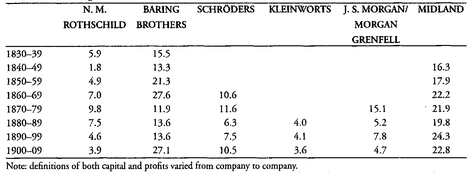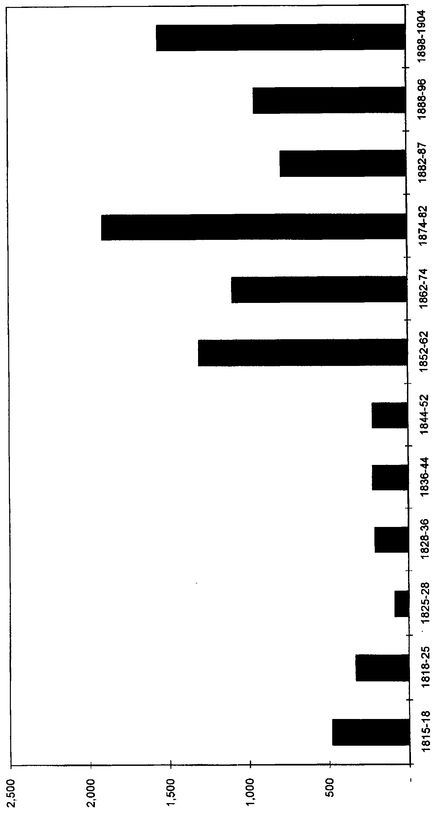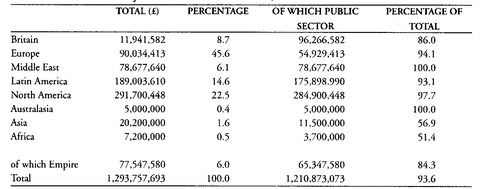Read The House of Rothschild Online
Authors: Niall Ferguson
The House of Rothschild (67 page)
A number of qualifications need to be made, however. Firstly, if the figures for the period 1830—69 are taken into account, the performance of N. M. Rothschild & Sons after 1879 was not in fact markedly worse than it was for the period before. The 1870s were an exceptional decade; the period before and the period after did not greatly differ from one another. To speak of decline relative to the past is therefore misleading. Secondly, by continuing to play safe, the Rothschilds
were
safe. The story of Barings presents a profound contrast in this period. The figures in table 9b also reflect the extent of the rival bank’s contraction as a result of the 1890 crisis; Barings’ high profit rate was partly a function of its dangerously narrow capital base.
were
safe. The story of Barings presents a profound contrast in this period. The figures in table 9b also reflect the extent of the rival bank’s contraction as a result of the 1890 crisis; Barings’ high profit rate was partly a function of its dangerously narrow capital base.
Table 9b: Profits at six major London banks as a percentage of capital, 1830-1909 (decennial averages).

Sources: RAL, RFamFD/13F; Roberts,
Schröders,
pp. 44, 57, 99, 527-35; Ziegler,
Sixth great power,
pp. 372-8; Wake,
Schröders,
pp. 44, 57, 99, 527-35; Ziegler,
Sixth great power,
pp. 372-8; Wake,
Kleinwort Benson,
pp. 472f.; Burk,
Morgan Grenfell,
pp. 260-70, 278-81; Holmes and Green,
Midland,
pp. 331-3.
pp. 472f.; Burk,
Morgan Grenfell,
pp. 260-70, 278-81; Holmes and Green,
Midland,
pp. 331-3.
The Rothschild combination of relatively low profitability and longevity recalls Friedrich Gentz’s illuminating point made as early as 1827 that one of the two fundamental Rothschild principles was:
never to strive for excessive profits in their undertakings, to give each of their operations clear limits and, no matter how much human ingenuity and caution it may require, to insulate themselves from the play of happenstance. In this maxim lies one of the chief secrets of their strength. There is no question that, with the means at their disposal, they could achieve far higher returns on this or that operation. But even if doing so would not have compromised the safety of their undertakings, they would in any case have made less in the end than they do by distributing their resources over a larger number of transactions which constantly recur and are repeated no matter what the [economic] conditions.
Nor should the fact that N. M. Rothschild fell behind Schröders and Kleinworts in the acceptance market necessarily be interpreted as a sign of decline: even if these figures are correct,
2
the Rothschilds were never as reliant on acceptances to generate their profits as other London merchants. As in the past, they concentrated their resources on the bond market and there they remained pre-eminent. Finally, the profits of the London house should not be looked at in isolation from those of other houses, a substantial part of which continued to be shared between the various partners. The profits of the combined Rothschild houses are difficult to calculate because of the large sums which were withdrawn as individual partners died, but illustration 9.ii presents appropriately adjusted figures. Once again, the impression is not one of decline: average annual profits slumped—by nearly half—in the depressed years 1874—9 (having exceeded £1 million between 1852 and 1874); but the years 1879—82 seem to have been the most profitable in the Rothschilds’ history (average annual profits were in excess of £4 million), and although this could not be sustained, the trend between 1888 and 1904 was upwards (from £785,000 a year in the mid-1880s to £1.6 million between 1898 and 1904).
2
the Rothschilds were never as reliant on acceptances to generate their profits as other London merchants. As in the past, they concentrated their resources on the bond market and there they remained pre-eminent. Finally, the profits of the London house should not be looked at in isolation from those of other houses, a substantial part of which continued to be shared between the various partners. The profits of the combined Rothschild houses are difficult to calculate because of the large sums which were withdrawn as individual partners died, but illustration 9.ii presents appropriately adjusted figures. Once again, the impression is not one of decline: average annual profits slumped—by nearly half—in the depressed years 1874—9 (having exceeded £1 million between 1852 and 1874); but the years 1879—82 seem to have been the most profitable in the Rothschilds’ history (average annual profits were in excess of £4 million), and although this could not be sustained, the trend between 1888 and 1904 was upwards (from £785,000 a year in the mid-1880s to £1.6 million between 1898 and 1904).
There is a useful parallel to be drawn here between the performance of the London Rothschilds and that of the British economy as a whole. For years, economic historians have argued that the British economy after around 1870 suffered from relative decline, noting the more rapid growth of the American or German economies in the period and the decline in Britain’s position as the dominant exporter of manufactures. While some have blamed this relative decline on “entrepreneurial failure” or even a culturally determined “decline of the industrial spirit,” others have identified the City of London as an institutional culprit which impeded the modernisation of Britain’s industry by encouraging excessive levels of capital export in the late nineteenth century. The Rothschilds had throughout the nineteenth century played a major role in encouraging this capital export, and continued to do so right up until 1914. The possibility therefore arises that Natty can be blamed not only for the decline of his own firm, but for that of the British economy as a whole.
The reality is that the decline of the British economy, like the decline of the Rothschilds before 1914, has been exaggerated. Capital exports were only starving British industry of investment if it can be shown that there was a capital shortage inhibiting firms from modernising their plant; there is little evidence to support this view. In fact, the high level of capital export from Britain was an integral part of the British economy’s global role as an exporter of manufactures, an importer of food and other primary products, the lender of last resort in the international monetary system, a major exporter of skilled colonists and, not least, the imperial guarantor of law and order on most seas and vast tracts of land (9.5 million square miles in 1860; 12.7 million in 1909). To measure the costs and benefits of this system too narrowly—in terms of the prosperity of those Britons who remained within the British Isles—is to miss the point. Some 444 million people lived under some form of British rule on the eve of the First World War: contrary to the nationalist propaganda of the decolonisation era, British statesmen could not and did not make economic policy solely for the benefit of the 10 per cent who happened to live in the United Kingdom. While the profits of overseas expansion unquestionably flowed to a relatively small elite of investors, the broad “multiplier” effects of British-financed investment and trade were felt far beyond Britain herself. Nor should the costs of governing and defending the Empire be exaggerated; the tax and debt burden incurred by Britain was in fact small relative to the enormous extent of British power and the economic benefits generated by a secure empire of more or less free trade, free capital movement and free migration.
Already by the 1850s British overseas investments totalled in the region of £200 million. In the second half of the century, however, there were three great waves of capital export. Between 1861 and 1872, net foreign investment rose from just 1.4 per cent of GNP to 7.7 per cent, before dropping back down to 0.8 per cent in 1877. It then rose more or less steadily to 7.3 per cent in 1890, before once again falling down below 1 per cent in 1901. In the third upswing, foreign investment rose to an all-time peak of 9.1 per cent in 1913—a level not subsequently surpassed until the 1990s.
3
In absolute terms, this led to a huge accumulation of foreign assets, rising more than tenfold from £370 million in 1860 to £3.9 billion in 1913—around a third of the total stock of British wealth. No other country came close to this level of foreign investment: the closest, France, had foreign assets worth less than half the British total, Germany just over a quarter. Britain accounted for something like 44 per cent of total foreign investment on the eve of the First World War. Although there was an inverse relationship between the cycle of foreign investment and that of domestic fixed investment, this high level of capital export should not, however, be understood in crude terms as a “drain” of capital from the British economy. It is also a mistake to see capital exports as in some sense “causing” the British trade deficit to widen. In fact, the income earned on these investments more than matched the export of new capital, just as (when coupled with revenue from “invisible” earnings) it invariably exceeded the trade deficit. In the 1890s net foreign investment amounted to 3.3 per cent of GNP, compared with net property income from abroad of 5.6 per cent. For the next decade, the figures were 5.1 and 5.9 respectively.
3
In absolute terms, this led to a huge accumulation of foreign assets, rising more than tenfold from £370 million in 1860 to £3.9 billion in 1913—around a third of the total stock of British wealth. No other country came close to this level of foreign investment: the closest, France, had foreign assets worth less than half the British total, Germany just over a quarter. Britain accounted for something like 44 per cent of total foreign investment on the eve of the First World War. Although there was an inverse relationship between the cycle of foreign investment and that of domestic fixed investment, this high level of capital export should not, however, be understood in crude terms as a “drain” of capital from the British economy. It is also a mistake to see capital exports as in some sense “causing” the British trade deficit to widen. In fact, the income earned on these investments more than matched the export of new capital, just as (when coupled with revenue from “invisible” earnings) it invariably exceeded the trade deficit. In the 1890s net foreign investment amounted to 3.3 per cent of GNP, compared with net property income from abroad of 5.6 per cent. For the next decade, the figures were 5.1 and 5.9 respectively.
9.ii: Average annual Rothschild profits (combined houses), selected periods (&thousand).

Why did the British economy behave in this way? The greater part of overseas investment was “portfolio” rather than “direct” in nature, in other words it was mediated by stock exchanges through sales of bonds and shares issued on behalf of foreign governments and companies. According to Edelstein, the explanation for the “pull” of foreign securities was that, even allowing for the higher degree of risk involved, their yields were rather higher (by around 1.5 percentage points) than those of domestic securities when averaged out over the period 1870-1913. However, this averaging conceals substantial fluctuations. Analysing the accounts of 482 firms, Davis and Huttenback have shown that domestic rates of return were sometimes higher than foreign—in the 1890s for example. Their work also quantifies the importance in the eyes of investors of imperialism, as rates of return on investments in the Empire were markedly different from those on investments in foreign territories not politically controlled by Britain: as much as 67 per cent higher in the period before 1884, but 40 per cent lower thereafter. Was the rising level of British investment abroad therefore an economically irrational product of imperialism—a case of capital following the flag rather than maximum profits? Much modern historiography tends to emphasise the non-economic motivations for the rapid expansion of the British Empire. On the other hand, Davis and Huttenback show that imperial possessions were not the main destination of British investment taken as a whole: for the period between 1865 and 1914, only around 25 per cent of investment went to the Empire, compared with 30 per cent for the British economy itself and 45 per cent for foreign economies. Their work points to the existence of an elite of investors with a material interest in the Empire as a mechanism for stabilising the international capital market
as a
whole. Late-nineteenth-century imperialism was the political accompaniment to an economic process similar to the “globalisation” of the late twentieth century.
as a
whole. Late-nineteenth-century imperialism was the political accompaniment to an economic process similar to the “globalisation” of the late twentieth century.
As leading members of that elite of imperial investors, the Rothschilds’ role in British imperialism was substantial. Public issues of foreign securities in London between 1865 and 1914 totalled £4,082 million. N. M. Rothschild & Sons were either solely or jointly responsible for over a quarter of this total (£1,085).
4
No other bank could match this, though Barings tried in the 1860-90 period and Pierpont Morgan came close thereafter, with the Seligman brothers not far behind and Ernest Cassel a formidable rival from the turn of the century. Table 9c gives a breakdown of the geographical distribution and type of Rothschild loans issued for the period after 1852.
4
No other bank could match this, though Barings tried in the 1860-90 period and Pierpont Morgan came close thereafter, with the Seligman brothers not far behind and Ernest Cassel a formidable rival from the turn of the century. Table 9c gives a breakdown of the geographical distribution and type of Rothschild loans issued for the period after 1852.
Table 9c: Loans issued by N. M. Rothschild & Sons, 1852-1914.

Sources: Ayer,
Century of finance,
pp. 14—81; RAL.
Century of finance,
pp. 14—81; RAL.
A comparison of the Rothschild figures with the data in Davis and Huttenback (see table 9d) reveals that N. M. Rothschild continued to be far more interested in government finance than in private sector issues. Only around 36 per cent of all “called up” capital between 1865 and 1914 was for governments; the equivalent figure for loans issued by the London Rothschilds in (approximately) the same period is over 90 per cent. (Almost all the rest was accounted for by foreign railway companies.) The extent of Rothschild dominance in government bond issues was astonishing. For the London market as a whole, foreign public sector issues between 1865 and 1914 amounted to £1.48 billion, of which close to three quarters were handled by the Rothschilds solely or in partnership. New Court also remained far more interested in Europe and far less interested in Britain than the London market as a whole, and was under-represented in African, Asian and Australasian issues. Perhaps the most striking difference of all, however, is that the Rothschilds were relatively uninvolved in imperial issues, which accounted for only 6 per cent of their business, compared with around 26 per cent for the British capital market as a whole. Given Natty’s and Alfred’s influential role in the politics of imperialism, this is a highly surprising finding, suggesting that they attached relatively little importance to the Empire as a field for their own private financial activities. To be more precise, they showed no preference for states (for example, Egypt) whose bonds were guaranteed by British financial control over states (for example, Brazil) which remained politically independent. It was therefore quite wrong to say (as Ernest Cassel said of Alfred) that the Rothschilds “would hardly take up anything that did not have the British government guarantee about it.”
Other books
The Up-Down by Barry Gifford
Cold as Ice by Charles Sheffield
The Takeover by Teyla Branton
The Diary of Lexi Ashford (Lexi Ashford: Part One) by Jessica Sorensen
The Journal: Ash Fall by Moore, Deborah D.
The Fall of Alice K. by Jim Heynen
The Butterfly Garden by Danielle Greyson
Betting the Farm by Annie Evans
One Step Too Far by Tina Seskis
Captain's Choice: A Romance by Darcey, Sierra
